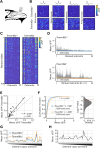This is a preprint.
Amplification of olfactory transduction currents implements sparse stimulus encoding
- PMID: 39416025
- PMCID: PMC11482904
- DOI: 10.1101/2024.10.11.617893
Amplification of olfactory transduction currents implements sparse stimulus encoding
Update in
-
Amplification of olfactory transduction currents implements sparse stimulus encoding.J Neurosci. 2025 Mar 17;45(18):e2008242025. doi: 10.1523/JNEUROSCI.2008-24.2025. Online ahead of print. J Neurosci. 2025. PMID: 40097179
Abstract
Sensory systems must perform the dual and opposing tasks of being sensitive to weak stimuli while also maintaining information content in dense and variable sensory landscapes. This occurs in the olfactory system, where OSNs are highly sensitive to low concentrations of odors and maintain discriminability in complex odor environments. How olfactory sensory neurons (OSNs) maintain both sensitivity and sparsity is not well understood. Here, we investigated whether the calcium-activated chloride channel, TMEM16B, may support these dual roles in OSNs. We used multiphoton microscopy to image the stimulus-response density of OSNs in the olfactory epithelium. In TMEM16B knockout mice, we found that sensory representations were denser, and the magnitude of OSN responses was increased. Behaviorally, these changes in sensory representations were associated with an increased aversion to the odorant trimethylamine, which switches perceptual valence as its concentration increases, and a decreased efficiency of olfactory-guided navigation. Together, our results indicate that the calcium-activated chloride channel TMEM16B sparsens sensory representations in the peripheral olfactory system and contributes to efficient integrative olfactory-guided behaviors.
Conflict of interest statement
Competing Interests Statement The authors declare no competing interests.
Figures






References
-
- Aungst JL, Heyward PM, Puche AC, Karnup SV, Hayar A, Szabo G, Shipley MT. Centre-surround inhibition among olfactory bulb glomeruli. Nature 426: 623–629, 2003. - PubMed
-
- Billig GM, Pál B, Fidzinski P, Jentsch TJ. Ca2+-activated Cl− currents are dispensable for olfaction. Nature neuroscience 14: 763–769, 2011. - PubMed
Publication types
Grants and funding
LinkOut - more resources
Full Text Sources
